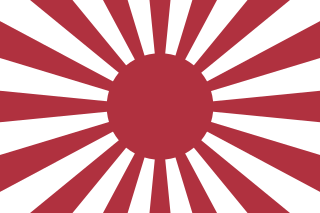A division is a large military unit or formation, usually consisting of between 10,000 and 25,000 soldiers. In most armies, a division is composed of several regiments or brigades; in turn, several divisions typically make up a corps.

A brigade is a major tactical military formation that typically comprises three to six battalions plus supporting elements. It is roughly equivalent to an enlarged or reinforced regiment. Two or more brigades may constitute a division.

The Type 94 tankette was a tankette used by the Imperial Japanese Army in the Second Sino-Japanese War, at Nomonhan against the Soviet Union, and in World War II. Although tankettes were often used as ammunition tractors, and general infantry support, they were designed for reconnaissance, and not for direct combat. The lightweight Type 94 proved effective in China as the Chinese National Revolutionary Army had only three tank battalions to oppose them, and those tank battalions were equipped only with some British export models and Italian CV-33 tankettes. As with nearly all tankettes built in the 1920s and 1930s, they had thin armor that could be penetrated by .50 caliber (12.7 mm) machine gun fire at 600 yards (550 m) range.

The Imperial Japanese Army (IJA) was the principal ground force of the Empire of Japan. Forming one of the military branches of the Imperial Japanese Armed Forces (IJAF), it was controlled by the Imperial Japanese Army General Staff Office and the Army Ministry, both of which were nominally subordinate to the Emperor of Japan, the supreme commander of IJAF. During the 20th century, an Inspectorate General of Aviation became the third agency with oversight of the IJA. At its height, the IJA was one of the most influential factions in the politics of Japan.

The Invasion of the Kuril Islands was the World War II Soviet military operation to capture the Kuril Islands from Japan in 1945. The invasion, part of the Soviet–Japanese War, was decided on when plans to land on Hokkaido were abandoned. The successful military operations of the Red Army at Mutanchiang and during the invasion of South Sakhalin created the necessary prerequisites for invasion of the Kuril Islands.
This article covers the Japanese garrisons on the by-passed Pacific islands from 1944 to 1945, including the Japanese mandated territory of the South Seas Mandate.
The order of battle for Operation Chahar, in the history of the Second Sino-Japanese War (1937–1945), was:

Kōji Sakai was a lieutenant general in the Imperial Japanese Army during the Second Sino-Japanese War

The Manchukuo Imperial Army was the ground force of the military of the Manchukuo, a puppet state established by Imperial Japan in Manchuria, a region of northeastern China. The force was primarily used for fighting against Communist and Nationalist guerrillas in Manchukuo but also took part in battle against the Soviet Red Army on several occasions. It initially consisted of former National Revolutionary Army troops of the "Young Marshal" Zhang Xueliang who were recruited after the Japanese invasion of Manchuria en masse, but eventually expanded to include new volunteers and conscripts. The Imperial Army increased in size from about 111,000 troops in 1933 to an estimated strength of between 170,000 and 220,000 soldiers at its peak in 1945, being composed of Han Chinese, Manchus, Mongols, Koreans, Japanese, and White Russians. Throughout its existence the majority of its troops were considered to be mostly unreliable by their Japanese officers and advisers, due to poor training and low morale.
The order of battle for the Battle of South Guangxi by country is as follows:

The '5th Division' was an infantry division of the Imperial Japanese Army. Its call sign was the Koi (Carp) Division. The 5th Division was formed in Hiroshima in January 1871 as the Hiroshima Garrison, one of six regional commands created in the fledgling Imperial Japanese Army. Its personnel were drafted from Hiroshima, Yamaguchi and Shimane.
There were two 11th Independent Mixed Brigades in the Imperial Japanese Army.

Between 1937 and 1945 the Japanese Imperial Army formed 126 Independent Mixed Brigades, typically composed of various units detached from other formations. Some were composed of separate, independent assets. These brigades were task organized under unified command and were normally used in support roles, as security, force protection, POW and internment camp guards and labor in occupied territories. An Independent Mixed Brigade had between 5,000 and 11,000 troops.
The Imperial Japanese Army 18th Independent Mixed Brigade was an Independent Mixed Brigade formed November 7, 1939, in occupied China. It was assigned to the 11th Army. The unit was engaged in the Central Hupei Operation during the Second Sino-Japanese War. The brigade was re-organized as the 58th Division on 2 February 1942.

The Fourteenth Area Army was a field army of the Imperial Japanese Army (IJA) during World War II. It was originally the 14th Army, formed on November 6, 1941, for the upcoming invasion of the Philippines. It was reorganized in the Philippines on July 28, 1944, when Allied landings were considered imminent. The Fourteenth Area Army was formed by reinforcing and renaming the Fourteenth Army.
Tsaoyang-Yichang Campaign 1 May – 18 June 1940
The 109th Division was an infantry division of the Imperial Japanese Army. Its call sign was the Courage Division. It was formed on 24 August 1937 in Kanazawa as a square division, simultaneously with the 108th division. The nucleus for the formation was the 9th division headquarters. It was subordinated from the beginning to the Japanese Northern China Area Army.
This article details the organization of the Imperial Japanese Army.
The 105th Division was an infantry division of the Imperial Japanese Army. Its call sign was the Diligent Division. It was formed 15 June 1944 in southern Luzon as a C(hey)-class security division. The nucleus for the formation was the 33rd Independent Mixed Brigade and Kawashima detachment. The division was initially assigned to the 14th area army









